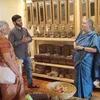This innovative eco-friendly stove is addressing sustainability issues in rural India
Developed at the University of Petroleum and Energy Studies, Neelam is a multifuel stove that promotes green energy, is more efficient, and emits less carbon monoxide than an average stove.
A majority of households in rural and semi urban areas in India rely on traditional biomass fuels for cooking, which represent a significant proportion of domestic primary energy consumption. However, these fuels are inefficient and produce harmful emissions, says Pankaj Kumar Sharma, Professor and Associate Dean, Academic Planning and Monitoring, University of Petroleum and Energy Studies (UPES).
This has fueled the demand for eco-friendly appliances in the country. While induction stoves help reduce the use of natural energy sources, this is a distant dream in villages where there is no good power supply.
In order to address sustainability issues across majority of the population and be a catalyst for inclusive growth in India, the UPES has come up with a multi fuel cooking stove called Neelam. It is capable of operating both on conventional and renewable energy sources available in rural and urban areas.

The eco-friendly stove developed by UPES.
Neelam Multifuel burning stove or choolha is an innovative new stove that promotes green energy while providing more efficiency and less CO emissions than an average stove.
It operates in four modes - pure biomass, pure biogas, pure LPG, and a combination mode.
“The biggest feature of the stove is its capability of operating both on conventional and renewable energy sources available in rural and urban area,” says Pankaj Kumar, who has developed and patented the product.
Features of the stove
The Neelam multifuel stoves are structured with two combustion chambers, that is, an upper combustion chamber and a lower combustion chamber, wherein the upper combustion chamber is positioned over the lower combustion chamber.
“These stoves are designed with the provision of producing heat out of the solid fuels within the lower combustion chamber while the upper combustion chamber is equipped with a removable hybrid burner kit to supply gaseous fuels to a cooking vessel,” Pankaj says.

Pankaj Kumar.
“The hybrid burner kit is also provided with a control mechanism to control the flow of gaseous fuels to the upper combustion chamber and subsequently to the cooking vessel,” he adds.
According to Pankaj, the stove reduces the amount of carbon monoxide produced during combustion by 85 percent to 100 percent. The reduction in the amount of carbon monoxide consequently raises the combustion temperature of the stoves, which subsequently increases the overall efficiency, he says.
While it requires occasional cleaning, the metal body of the stove lowers its production costs and increases its durability. Each of these choolhas costs about Rs 600. However, the product is still in the testing phase and has not yet received any additional funding.
The impact
“When we initially started the project, we provided families living in Pithoragarh district, Uttarakhand, with the multifuel stove. Currently, we are working towards phase II of the stove. We are also developing a stove using pine needles, which is highly inflammable and a major cause of forest fire in Uttarakhand forests,” says Pankaj.
“Once we develop and test the prototype, we intend to build more stoves and send them to villages in the hilly regions,” he adds.
Being one of the first stoves that runs on LPG, biogas, and biomass at the same time, Neelam aims to ease the burden of people, especially women, who have to travel long distances to organise fuel for choolhas.

The stove operates in four modes - pure biomass, pure biogas, pure LPG, and a combination mode.
It also aims to streamline the cooking process in villages by minimising pollution and reducing the hazardous effects on health while cooking on conventional handmade choolhas.
“Moreover, now that the government is providing LPG in rural areas and rest of the fuels are easily available in the villages, this stove is helpful in saving energy and protecting the environment at the same time,” Pankaj explains.
Talking about the challenges, he says that it was a strenuous process to assemble the different sources of fuel for cooking in one particular stove, and said that they had to deep dive in the construction of the stove during the research period.
Road ahead
While the stove is slowly expanding in many places for deployment, they are now looking to collaborate with the government to facilitate a bigger plan.
“We are in talks with the Ministry of Rural Development to equip these stoves in government schools for the preparation of food for mid-day meals. Additionally, we are in the process of researching other natural resources that can be incorporated in these stoves for fuel generation,” says Pankaj.
“By focusing on the model of rural entrepreneurship, we can train women and men in villages to make these stoves, and expand the reach and production of the product,” he signs off.
Edited by Megha Reddy








